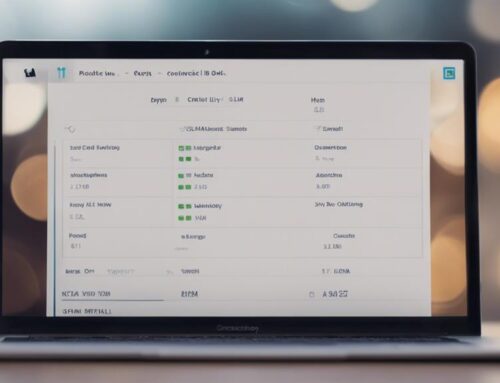Master data entry best practices by establishing clear guidelines for accuracy, implementing systematic error checks, and streamlining workflows. Utilize data validation rules, double-check entries, and prioritize accuracy verification. Train with online modules, practice in simulated environments, and track progress for improvement. Ensure meticulous attention to detail, verify data against sources, and prevent errors through consistent validation. Implement error detection mechanisms, cross-verify information, and continuously work on enhancing processes. By following these practices, you’ll be on the path to mastering efficient and reliable data entry techniques.
Key Takeaways
- Implement validation rules to ensure data accuracy and reliability.
- Use error handling to provide clear messages for issue correction.
- Double-check entries against original sources to catch discrepancies.
- Utilize online training modules for skill enhancement and practice.
- Continuously review data and implement checks and balances to minimize errors.
Quality Control
When implementing quality control measures in data entry processes, it is crucial to establish clear guidelines and standards for accuracy and consistency. Error identification plays a pivotal role in ensuring data integrity. By implementing systematic checks and balances, you can proactively identify and rectify errors before they propagate through the system. Process optimization is another key aspect of quality control in data entry. Streamlining workflows, eliminating redundancies, and automating repetitive tasks can significantly enhance the efficiency and accuracy of data entry processes.
To optimize the data entry process, consider conducting regular audits to identify areas for improvement. By analyzing error trends and identifying common pitfalls, you can develop targeted training programs to address specific issues. Additionally, implementing feedback loops where data entry specialists can provide input on process bottlenecks can lead to continuous refinement and enhancement of overall data entry quality. Remember, quality control is an ongoing process that requires diligence and a commitment to excellence.
Data Validation
To ensure data accuracy and reliability, data validation is a critical step in the data entry process. Input validation is essential for catching and correcting errors before they affect the database. By implementing validation rules, such as required fields, specific formats (like dates or phone numbers), and range checks, you can ensure that only accurate and meaningful data is entered.
Error handling is another crucial aspect of data validation. When errors occur during data entry, it’s important to provide clear and concise error messages to guide users on how to correct the issue. Proper error handling helps maintain data integrity by preventing incorrect or incomplete data from being stored.
Data validation not only improves the quality of your database but also saves time and resources by reducing the need for manual data cleaning. By enforcing validation rules and implementing effective error handling mechanisms, you can enhance the overall reliability and usability of your data.
Double-Checking
When it comes to data entry, double-checking is a crucial step in ensuring accuracy. By implementing an accuracy verification process, you can catch and rectify any errors before they cause issues downstream. Emphasizing the importance of review can significantly reduce the likelihood of inaccuracies in your data entries.
Accuracy Verification Process
Implementing a systematic double-checking process is essential to ensuring the accuracy of data entry. This verification process is critical for maintaining data integrity within databases. Double-checking involves reviewing the data entered against the original source to identify and correct any errors. By verifying the accuracy of each entry, you significantly reduce the risk of inaccuracies that could impact decision-making processes. Double-checking ensures that the information entered is precise and aligned with the source data, enhancing the overall quality of your database. Incorporating this step into your data entry routine not only improves the reliability of your records but also minimizes the chances of costly mistakes. Double-checking is a simple yet effective method to enhance data accuracy and integrity.
Importance of Review
Incorporating a systematic review process into your data entry workflow is crucial for ensuring the accuracy and integrity of your database. The review process involves double-checking the entered data to catch any errors or inconsistencies that may have occurred during the initial data entry phase. By implementing a thorough review process, you can significantly reduce the likelihood of inaccuracies that could lead to costly mistakes or faulty analysis down the line. Regularly reviewing your data also helps to maintain data integrity by ensuring that the information stored in your database is reliable and up to date. Make it a habit to double-check your entries to maintain the quality and trustworthiness of your data.
Training Resources
Consider utilizing online training modules to enhance your data entry skills efficiently. Online courses offer a flexible way to learn at your own pace, focusing on specific areas such as software tutorials and practical exercises. These resources provide hands-on training, allowing you to practice data entry techniques in a simulated environment before applying them in real-life situations.
Software tutorials guide you through the functionalities of different data entry tools, helping you understand the specific features and shortcuts that can streamline your work. Practical exercises offer interactive scenarios where you can apply your knowledge and improve your speed and accuracy. Online courses often include assessments to track your progress and identify areas for improvement, ensuring a comprehensive learning experience.
Data Accuracy
To ensure data accuracy, meticulous attention to detail is essential in every data entry task you undertake. Data verification plays a crucial role in maintaining the integrity of the information entered. Double-checking the data you input against the original source can help catch any discrepancies and ensure that the information is accurately transcribed. This process not only verifies the accuracy of the data but also serves as a method of error reduction.
Incorporating systematic checks and balances within your data entry workflow can significantly minimize errors. Implementing validation rules and automated tools can help flag potential inaccuracies before they become larger issues. By continuously reviewing and verifying the data you enter, you contribute to maintaining high levels of accuracy within your database.
Error Prevention
To prevent errors in data entry tasks, utilize systematic checks and balances to ensure accuracy and integrity in your work. Implementing error detection mechanisms such as double-entry verification can significantly reduce mistakes. When entering data, take the time to cross-verify information to catch any discrepancies early on. Additionally, setting up validation rules within the data entry fields can help prevent common errors like typos or incorrect formats.
Another effective method for mistake prevention is to limit access to sensitive data entry fields only to authorized personnel. By restricting access, you can minimize the risk of unauthorized changes or accidental deletions. Regularly updating and maintaining data entry systems also plays a crucial role in error prevention. Outdated software or systems may be more prone to errors or glitches, so ensure that you are working with the latest versions and patches.
Continuous Improvement
Improving data entry processes requires a systematic approach focused on identifying inefficiencies and implementing targeted enhancements. Process optimization is key to enhancing efficiency in data entry. Regularly review your data entry procedures to identify areas where workflow streamlining can lead to a productivity boost. Implementing automation tools can help reduce manual entry tasks and minimize errors. Analyzing data entry metrics can provide insights into areas that require improvement, enabling you to make informed decisions on process enhancements. Encourage feedback from data entry operators to understand their pain points and suggestions for improvement. Continuous improvement in data entry is a dynamic process that requires a proactive mindset and a commitment to refining processes over time. By fostering a culture of continuous improvement within your data entry team, you can ensure that your processes remain efficient and effective in meeting the evolving demands of your organization.
Frequently Asked Questions
How Can Data Entry Best Practices Be Tailored to Different Types of Industries or Organizations?
When tailoring data entry best practices to different industries or organizations, consider industry-specific strategies. Customized solutions ensure alignment with your organization’s needs. For example, healthcare may focus on patient data accuracy while retail prioritizes inventory management efficiency.
What Are Some Common Challenges Faced by Data Entry Professionals and How Can They Be Overcome?
To excel in data entry, focus on quality control to prevent errors. Prioritize time management for efficiency. Overcome challenges by implementing strict quality checks, utilizing automation tools, and establishing clear processes to streamline workflows and enhance accuracy in data entry tasks.
Are There Any Specific Software Tools or Technologies That Can Help Streamline the Data Entry Process?
To streamline data entry, consider using automation tools for efficiency. Data cleansing software helps maintain accuracy. Machine learning and OCR technology enhance speed and accuracy. Implementing these tools can significantly improve your data entry process.
How Can Data Entry Professionals Stay Up-To-Date on the Latest Trends and Developments in the Field?
To keep abreast of the latest trends in data entry, continuously learn and stay updated on industry developments. Explore new technologies, attend workshops, and engage with online communities to enhance your skills and knowledge.
What Are Some Key Metrics or KPIS That Can Be Used to Measure the Effectiveness of Data Entry Processes?
To measure data entry effectiveness, focus on error reduction, time efficiency, accuracy improvement, and quality assurance. Key metrics include error rate, processing speed, accuracy percentage, and adherence to standards. These indicators ensure optimal performance.




